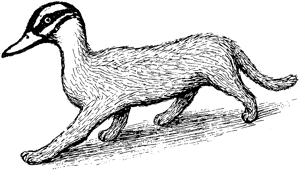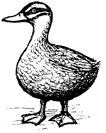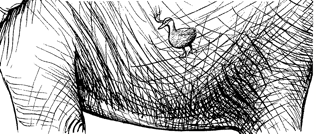A Duck is Not a Humanby Eddy Burger |
|
|
part 2 |
The Pond Skating Duck is a remarkable example of a species that has adapted to suit its environment. With the destruction of its natural habitat, its descendants were driven into colder and colder climes, where the water was so cold against the ducks bellies that it rendered them infertile.
The members of the population who did survive were those with particularly large feet that enabled them to walk on water — so to speak — thus keeping their sensitive bellies out of the water. Yet the feet of these birds had become so big that they could no longer fly, and thus they became prey to such predators as the Arctic Fox and the Snow Leopard.
Those descendants that survived these predators possessed two important characteristics. Firstly, they had developed a strong sense of smell, enabling them to detect the scent of a predator in time to swiftly duck for cover — so to speak — by plunging their bodies into the icy cold water, which they did only occasionally and for brief periods, so the temperature of the water did not effect their sperm count.
Secondly, they would still have been sitting ducks — so to speak — if not for the second important characteristic: those that did not get picked off like ducks — so to speak — were those with exceptionally large feet — feet that were so big (and unusually shaped) that they looked like water lily pads. So when a duck ducked underwater, its big wide webbed feet — which remained resting upon the water’s surface — were mistaken for lily-pads.
The Pond-Skating Duck is closely related to The Lily-Pad Duck, however it is only via chance that the Lily-Pad Duck has feet that look like lily-pads, owing to a random deformity in an ancestor than to natural selection.
The gannet tried to mate with the duck, and while it was doing so, a third leg suddenly grew out of the duck’s face. The duck was bewildered. It kicked the gannet between the legs. To grow a leg in such a manner is a very uncommon occurrence, which can be accounted for — perhaps — as the product of a sympathetic, psychosomatic reaction to an unconscious fear that such cross-mating might cause deformity in their offspring.
So not only is cross-breeding common between farmers and farm animals, but the animals themselves practice it frequently upon each other, even without the influence of humans who — in their endeavours to produce superior stock — might — for example — cross a cow with a carrot to produce orange meat, cross a sheep with a wool factory to produce those absurd wool machines that count as sheep today, or cross a cow with a duck to produce a cow that floats (and has webbed hooves). Australia is a haven for mutations.

A cat that does not eat ducks
(This illustration was drawn from life.) |
For a duck, Eleanor Duck was quite unusual in that she did not have a bill or feathers and was very tall. But she is by no means unique among the duck kingdom. Equally remarkable are the Long Legged Duck, the Big Eyed Duck and the Big Eared Duck.
The Bandicoot Duck and the Butterfly Duck do not look like ducks at all, whilst the Human Duck, though also remarkable, does bear some resemblance to Eleanor Duck. The Human Duck (not to be confused with the Hairy Duck) also behaves quite differently from any other duck. Although it is adept at adopting anthropic behaviours, its method of cracking eggs (which it accomplishes by picking up rocks in its mouth and lobbing them onto the eggs) distinguishes it from other ducks.

A Human Duck
|
I find this theory rather unlikely since I — a human, not a duck — have personally been in the proximity of ducks on several occasions — at least, I think they were real ducks — and I am quite certain that the people who accompanied me on each occasion were also probably not ducks either.
The Three Legged Duck (not to be confused with the Deformed Duck) is adept at climbing pine trees. Yet it is during such acts of tree climbing that it sometimes comes to grief: Whilst the duck’s third foot enables it to perform certain feats, any advantage it might gain through the feats of its feet are defeated when its third foot falls foul to chance.

|
The duck, the gannet and the coot walked up a hill together. Then they walked down. The duck got its foot stuck in a hole. Then its leg broke off. And that is how the One Legged Duck came to have only one leg.
The duck, the gannet and the coot were walking down a country road. Then from all directions appeared bustards, many of them covered in blood. There were bloody bustards everywhere. They were funny looking, these bustards. One had a head like a Spotted Dick. An eagle attacked this bloody dick-head and made a real pudding of it.
One bustard was a real cock-head and another looked like a Khunt. The duck, the gannet and the coot hid in a thicket until all the bustards had passed them by. Beware of bloody bustards — that was the lesson they learned today. Whenever bloody bustards are near, an eagle could be far behind.
The duck, the gannet and the coot came across a cow that was grazing near a fence. “Why are your udders so full?” asked the duck. “Your calf must be starving!”
“Fences define our lives just as land defines yours. Why are you so far away from water?” asked the cow.
“We have come to learn about the world away from water.”
“But you cannot escape it. I get my water from a pump.”
“But why are your udders so full?”
“I get my water from a pump.”
Beware of cows — that was the lesson they learned today.
The duck, the gannet and the coot came unto a chicken. “You have so many eggs,” said the duck. “You must be worn out from having sex all the time?”
“Beware of the fox that is disguised as a duck,” said the chicken. Then it gave them three magic pellets. That evening, the duck stuck the pellets into its ear. By morning, the pellets had sprouted into another leg. And that is how the One Legged Duck became a Three Legged Duck with only two legs.

A fox disguised as a duck A Big Eared Duck
|
Generally speaking, a woman is a cow. A male — on the other hand — is called a bull. But a duck is a duck. A female duck is certainly a duck, and a man-duck is commonly referred to as a duck, though it is also called a drake. A mandrake — however — is not a duck.
A mandrake is a Eurasian solanaceous plant that was thought to have magical properties (not to be confused with the Eurasian Coot). The coot was made into a narcotic (the effects of which led to the expression “As dumb as a duck”).
Did you know that “eiderdown” comes only from women-ducks? Did you know that only women-ducks quack? Did you know that a duck’s quack does not echo; this phenomenon is currently being researched by military scientists involved in the development of new stealth technology.
Did you know that someone with anatadephobia is afraid that they are being watched by a duck?
Did you know that of all the animals in the animal kingdom, the Argentine Duck has the longest penis in comparison to its body length?
Did you know that — generally speaking — ducks in Australia do not fly south for the winter?
Did you know that the duck’s ability to fly in formation is only possible through psychic communication between ducks? The psychic part of the brain has been identified in ducks, which is also present in humans, proof that all humans have natural psychic ability.
Did you know that the first eiderdown quilt actually originated from the practice of storing Eider Ducks within big cloth bags? One day, a farmer utilised such a bag to keep herself warm on a particularly cold winter’s night. It contained about ten ducks. It was lumpy and very noisy but it did the job. To overcome the noise problem, she later tried filling it with dead ducks, then she tried cooked ducks and duck giblets, till eventually she filled it just with feathers, and so the eiderdown quilt was born.
To be continued...
Copyright © 2008 by Ed Burger
